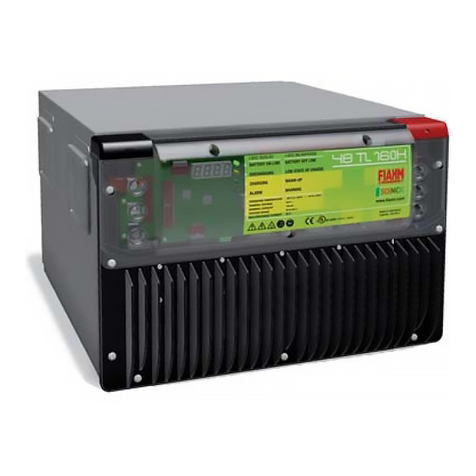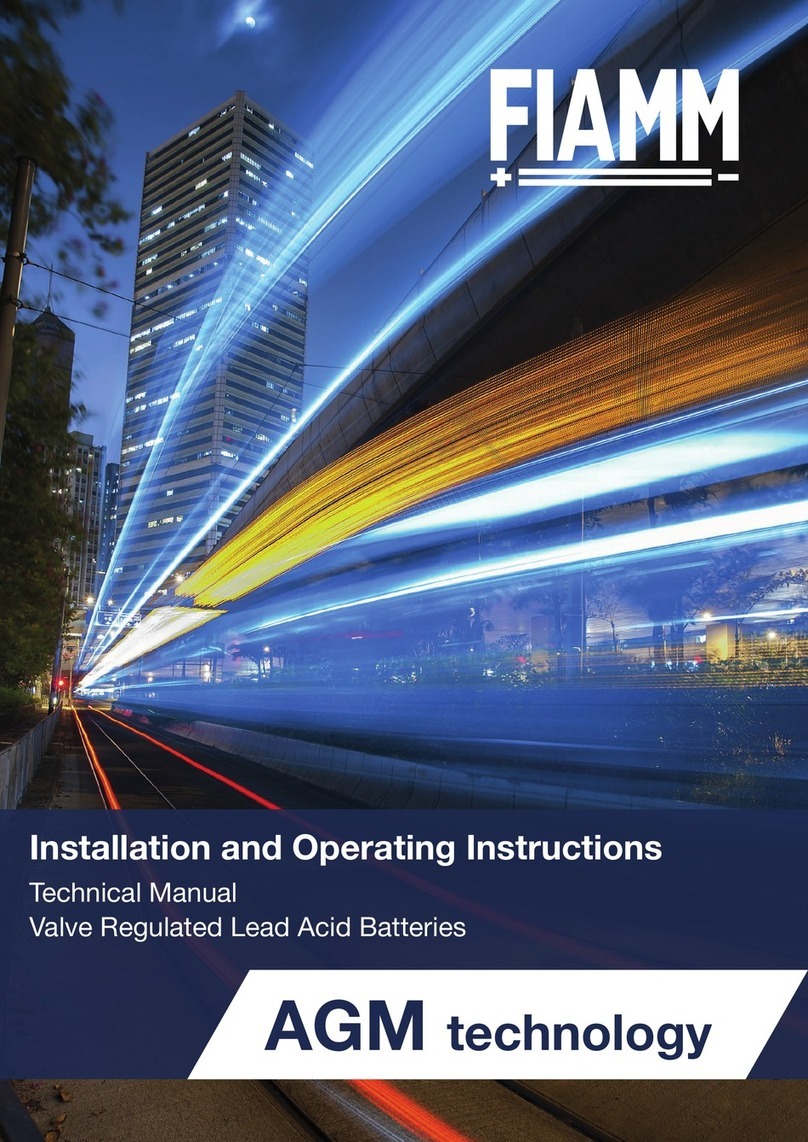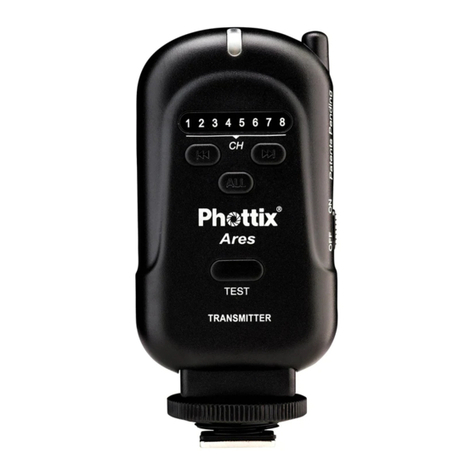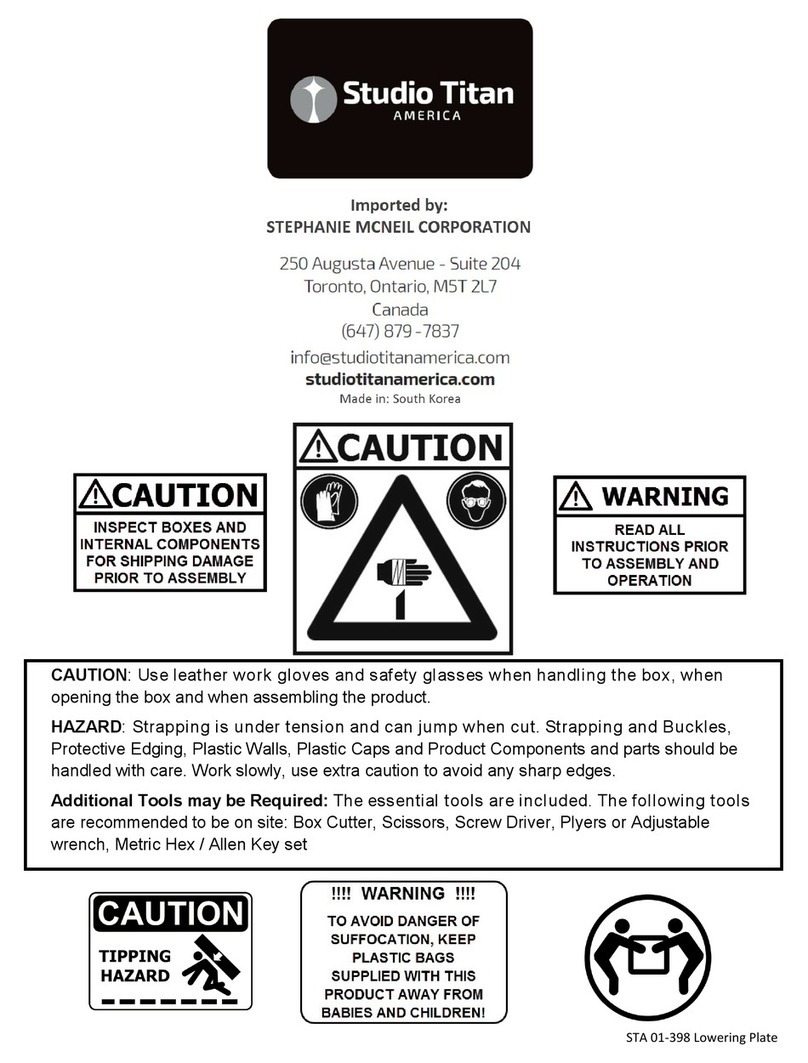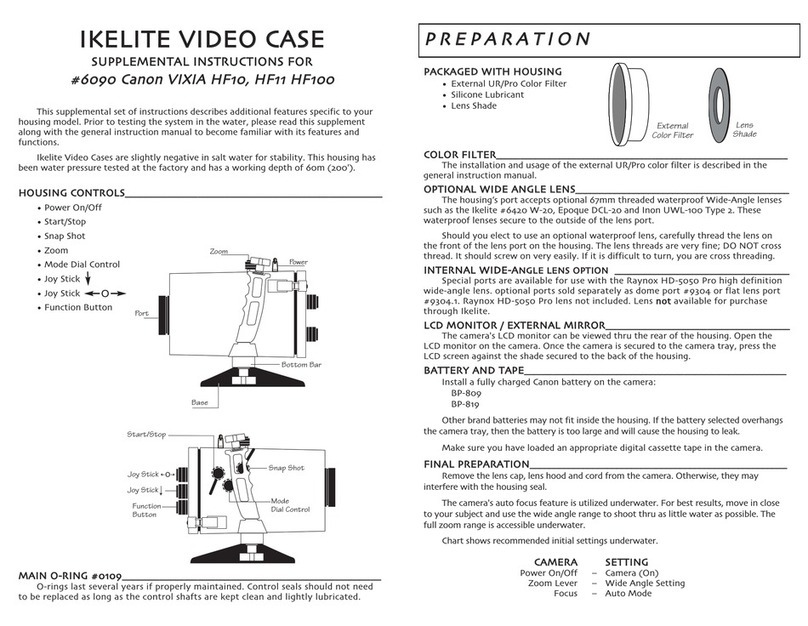Fiamm FLX Manual


FIAMM Industrial Batteries December 2012
FIAMM AGM Valve Regulated Recombination Batteries: FLX Series- Engineering Manual
This document and any confidential information it contains shall be distributed, routed or made available solely with written permission of
FIAMM. FIAMM reserves the right to change or revise without notice any information or detail given in this manual Page
1
TABLE OF CONTENTS PAGE
1 OPERATING CHARACTERISTICS 2
2 INSTALLATION 4
3 CHARGING 6
4 STORAGE AND REFRESH CHARGING 8
5 MAINTENANCE AND TESTING 9
6 SAFETY 10
7 APPLICABLE STANDARDS 10
8 RECORDS DATA 10

FIAMM Industrial Batteries
FIAMM AGM Valve Regulated Recom
This document and any confidential
informa
FIAMM. FIAMM reserves the right to change
1 OPERATING
C
Capacity
and final discharge vo
Battery
capacity is rated in Ampe
discharging rate of 20 h
ours to 1.
FIAMM FLX Series batteries
can
vice versa.
Internal resistance and short ci
The internal resistance and sho
plate thickness, number of plates
charge and other variables.
Product ratings
are determined
described in IEC or BS standards
Voltage
The voltage of lead acid cells is
electrode materials (PbO
2
and Pb
on the electrolyte concentration in
Power
Design life
ombination Batteries: FLX Series
- Engineering Manual
ation it contains shall be distributed, routed or made available sole
ge or revise without notice any information or detail given in this m
CHARACTERISTICS
voltage
peres per hours (Ah). Nominal capacity is usually
1.75 volt per cell at 77°F
for different applications.
an be discharged to
a lower voltage using hi
ghe
circuit current
ort circuit current of a battery are functions of its
tes, separator material,
electrolyte specific gravity,
ed
through performance test
ing done in accor
ds.
is
related to the electrochemical potential differenc
Pb) in the presence of electrolyte (sulphuric acid).
in contact with these elec
trodes and the state
of c
FIG.1 – POWER
December 2012
lely with written permission of
manual
Page
2
ly declared according to
er discharge current or
its construction design,
ty, temperature, state of
ordance
with methods
nce between the active
). Its value
is dependent
charge
of the battery.

FIAMM Industrial Batteries December 2012
FIAMM AGM Valve Regulated Recombination Batteries: FLX Series- Engineering Manual
This document and any confidential information it contains shall be distributed, routed or made available solely with written permission of
FIAMM. FIAMM reserves the right to change or revise without notice any information or detail given in this manual Page
3
According to international standards a battery is considered at the end of its service life when the
battery delivers less than 80% of its rated capacity. FIAMM FLX batteries have a design life of up to 10
years. Confirmation of service life comes not only from consistent feed-back from field applications, but
also from extensive accelerated thermal testing.
Operation at temperatures higher than 77° F reduces the performance life expectancy of a battery.
Service life of the battery is also affected by the float voltage chosen for battery charging, as showed in
figure 2.
FIG.2 – EXPECTED SERVICE LIFE VS FLOAT VOLTAGE RANGE
Capacity in relation to the temperature
The capacity available from a battery, at any particular discharge rate, changes according to the
working temperature.
Capacity in relation to the discharge rate
The capacity available from a battery depends also on the rate of discharge. For FIAMM FLX batteries
at 77°F please refer to table 1.
Table 1 – AVERAGE CAPACITY VS DISCHARGING RATIO
DISCHARGE RATE
(hours)
END
VOLTAGE
CAPACITY
(% of C20 Ah)
FLX
20 1.75 100
10 1.80 90
5 1.80 85
3 1.80 77
1 1.75 63

FIAMM Industrial Batteries December 2012
FIAMM AGM Valve Regulated Recombination Batteries: FLX Series- Engineering Manual
This document and any confidential information it contains shall be distributed, routed or made available solely with written permission of
FIAMM. FIAMM reserves the right to change or revise without notice any information or detail given in this manual Page
4
Self discharge
The state of charge of lead acid batteries slowly decreases while on open circuit due to self discharge.
In FIAMM FLX batteries, the rate of self discharge is approximately 2% per month at 77°F (+/- 5° F). In
case of extended storage it is necessary to refresh the batteries every 6 months to avoid a permanent
loss of capacity.
Cycling
FIAMM FLX batteries have been tested successfully according to the latest cycle life test procedure
standards specified for VRLA batteries (IEC and BS).
Gassing
Having a very high recombination efficiency (>99%), for batteries operated at 77° F and under normal
operating conditions, gas release is negligible. Laboratory test measurements show the following
gassing rates under normal operating conditions (2.27 Vpc, 77°F):
•1
st
week of service 80cc/Ah/day
•2
nd
week of service 10cc/Ah/day
•After stabilization (2 months) 2cc/Ah/day
Battery rooms or cabinets should have natural ventilation and should not be fully sealed.
Operation of batteries in parallel
When the required capacity exceeds the capacity of a single string of batteries, it is common practice to
connect strings in parallel. It is important to pay attention to the following guidelines:
•In each string only batteries of the same type, model, age and quantity should be used;
•A symmetrical layout of the batteries should be designed (i.e. length and type of connector)
to minimize possible resistance variations;
•Number of strings in parallel should be reasonable in terms of layout and application. If
strings are properly cabled, with equal voltage losses for each string, multiple strings can be
connected in parallel, safely to reach required total capacity.
2 INSTALLATION
Unpacking and inspection
Upon receiving a shipment of batteries it is important to check it carefully against related packing list.
Even though each consignment is certified and inspected by FIAMM before shipping, missing parts or
damages could be caused by mishandling during transportation. Any damage or any specific problem
found must be reported immediately by the consignee to the carrier and to the manufacturer for further
insurance or legal actions.
FIAMM FLX batteries are shipped fully charged with terminal posts insulated to avoid any possible short
circuit.
Batteries delivered in cabinets
For safety reasons, it is not advisable to pre-assemble batteries strings into cabinets before shipping
equipment to the site. However, if this is necessary, it is strongly recommended to protect the battery
system from mechanical stress and vibrations occurring during transportation. Batteries should be
properly fastened to the relevant cabinet shelves by means of plastic band and/or other adequate
methods. Furthermore the cabinets should be protected using shock-absorbing packaging material.
Special precautions must be taken to avoid accidental short circuits.
Handling requirements
Batteries are heavy so they require proper care in handling. Always lift each cell/block from underneath
or by the lifting handles. Never apply force to, or drop anything on, the terminal posts.
Room requirements
Batteries should be installed in a clean, cool, dry room on insulated racks or in a cabinet. Care must be
taken in providing adequate floor loading capability and sufficient aisle space for servicing. Good
lighting is also important to carry out visual inspections. Access to the battery room must be restricted to
qualified personnel only.

FIAMM Industrial Batteries December 2012
FIAMM AGM Valve Regulated Recombination Batteries: FLX Series- Engineering Manual
This document and any confidential information it contains shall be distributed, routed or made available solely with written permission of
FIAMM. FIAMM reserves the right to change or revise without notice any information or detail given in this manual Page
5
Ventilation in battery room
Under normal operating conditions, the gassing rate of FIAMM FLX Series batteries is extremely low.
However, the battery room should have sufficient ventilation to avoid temperature rise in the event of
unexpected circumstances such as overcharge due to a charger malfunction. As accelerated
recombination reaction generates heat, it is important that there allowances in ventilation to dissipated
excess heat through ventilation or air conditioning.
Temperature control in battery room
Battery life and performance are optimal at a temperature of 77° F. Operation at lower temperature will
reduce available capacity (for the period of time that the battery remains at low temperature). Higher
operating temperatures affect battery performances and will shorten the battery service life. Air
circulation within the battery room must be sufficient to avoid hot or cold spots. The total temperature
spread between the hottest and the coldest cell of the same string should be maintained inside a
window of +/- 5°F.
Racks
Battery racks should be grounded and made of acid resistant and insulated material. For safety reasons
they should be installed as level as possible. The depth and the height of the racks, along with servicing
headroom, should allow both adequate ventilation and a satisfactory servicing.
Cabinets
Good ventilation is extremely important for battery cabinets. Ventilation openings should be both at the
bottom of the cabinet, and as close as possible to the top, to prevent any hydrogen accumulation in an
abusive situation. Cabinets should be placed/fastened steadily to the floor.
Installation procedure
For a proper installation clean the blocks with a soft dry antistatic cloth or soft water-moistened cloth.
Place each cell/block at their correct position according to the electrical layout. Start with the lowest
shelf to ensure stability. Inter-tier and inter-row connections should be applied only once all blocks have
been connected properly. For proper ventilation and airflow maintain a distance of .25” or greater
between all battery blocks.
Interblock connecting procedure
It is extremely important to ensure proper surface contact between battery terminal posts and cables
(recommended) or solid connectors used to complete each string. Each connecting surface must be
clean and without oxidation. If required use very fine grit abrasive paper to remove any dirt on each
surface. Do not use wire brushes or similar tools that may damage the plating film around terminals’ and
connectors’ copper. Then apply a light coating of No-Ox grease to the terminals and connectors prior to
installation of the connection hardware.
Terminal torque settings
To ensure a proper electrical connection between the flat surface of each terminal and the connector a
calibrated torque wrench must be used. Torque the electrical connections to the settings in Table 2.
Table 2 – TORQUE SETTING VALUES
Battery Terminal Type Torque (in-lbs)
Final checking of connections
To perform a final check of the connections it is advisable to measure the overall battery voltage and
make sure that this value is equal to the open circuit voltage of an individual block multiplied by the
number of blocks.
Paste a sticker with a progressive number to each block, making sure that the surfaces are dry and
clean. It is a good practice to number the blocks beginning with #1 at the positive end of each string.

FIAMM Industrial Batteries December 2012
FIAMM AGM Valve Regulated Recombination Batteries: FLX Series- Engineering Manual
This document and any confidential information it contains shall be distributed, routed or made available solely with written permission of
FIAMM. FIAMM reserves the right to change or revise without notice any information or detail given in this manual Page
6
Connection of the battery to the rectifier/load
The end positive terminal of each string of batteries should be connected to the positive terminal of the
charger, and the battery negative to the charger negative. Same procedure needs to be used for load
connections. A proper selection in cables and connectors should be used to avoid excessive voltage
drop, as well as overheating in case of high rate discharge. If a large section of cables are used their
weight should not stress cell/block terminals. A good method to use is to affix cables on the rack or the
nearby wall.
3 CHARGING
Introduction
After installation, in order to ensure the best protection against power failures, it is necessary that
batteries are kept in the following conditions:
•float charged throughout their standby period;
•fully recharged soon after a discharge.
Recharging process can be performed in several ways, depending on the site and equipment
conditions, but there are two main methods:
•float voltage recharge
•boost charge
The IU recharge method, also known as the modified constant voltage recharge, has been used for
many years and in a variety of applications. This method combines the need to have the battery quickly
recharged while ensuring maximum battery life. With this method, recharge starts at a constant current
rate. The voltage increases up to a pre-set value. The pre-set voltage is maintained and the current
then decreases to a minimum defined value. Finally, the recharge is completed at a final constant
voltage value equal to or less than that defined for float charge with the current decreasing to the value
used in float.
•
For UPS systems that do not utilize a constant float voltage charging profile or use an
Advanced Battery Management charging profile please set the charging parameters per
table 3.
Table 3 – ALTERNATE CHARGING PROFILE SETTINGS
FLX MODEL CURRE T LIMIT VOLTAGE
Recommended procedure for initial charging
For a safe installation of FIAMM FLX batteries only constant voltage chargers should be used.
The best charging method operates with a preset constant voltage value supplying an automatically
limited charging current. It is called constant voltage charging with current limit and automatic
crossover.
An initial charge of 2.35 to 2.40 volts per cell for at least 24 hours (at 77° F) is suggested during
commissioning or before a capacity test in order to be sure that the battery is in fully charged condition.

FIAMM Industrial Batteries December 2012
FIAMM AGM Valve Regulated Recombination Batteries: FLX Series- Engineering Manual
This document and any confidential information it contains shall be distributed, routed or made available solely with written permission of
FIAMM. FIAMM reserves the right to change or revise without notice any information or detail given in this manual Page
7
Float operation for standby use
For standby applications the recommended float voltage window is between 2.25 to 2.30 volts per cell
depending on the model and on site temperature, as showed in table 4 (charger’s float voltage
tolerance is within ±0.005 volt per cell).
Table 4 – FLOAT VOLTAGE VS SITE TEMPERATURE
Site Temperature
(°
°°
°F)
Float voltage per cell
FLX
60 2.29
64 2.285
68 2.28
72 2.275
75 2.27
77 2.27
79 2.265
82 2.26
86 2.255
90 2.25
93 2.245
97 2.24
100 2.235
104 2.23
Residual current
Whenever battery chargers are working properly (and in accordance with manufacturer instructions) it is
normal to have a residual float current in fully charged batteries. Residual float currents will slowly
increase during a batteries life and according to cycle frequency. Although the charger is set on a fixed
average voltage, it is normal to record a spread in voltage between each block inside a string. Voltage
variation within ±250mV/battery is considered as a normal value particularly in the first 12 months from
initial installation.
Recharge following discharge for standby use and boost charge
At the first installation, or soon after a discharge, the recommended recharge method is to use a
constant voltage equal to the float charge voltage with a maximum charge current of 25% of nominal
capacity.
To reduce the recharge time, the IU recharge method can be used with a higher voltage of 2.35-2.40
V/cell at 77° F for 24 hours and a current limit of 0.25 C
10
. This process, also called boost charging,
should be applied only when batteries are not in a fully charged condition and need to be recovered in a
short period of time.
The battery should be placed back on float as soon as possible, ideally as soon as the charge current
has dropped below 20 mA/Ah (or lower if the application has frequent power failures).
Boost charge should be used only when necessary. Frequent equalize charging can result in more
water consumption, which will lead to reduced capacity and shortened battery life.
Float voltage and recharge procedures for frequent discharge applications
Whenever FIAMM FLX batteries are used in applications with frequent power failures (such as several
discharges a month) float voltage should be set at a higher range compared with a standby applications
range (i.e. from 2.27 to 2.30 volt per cell at 68-77°F). The recommended float voltage values necessary
to maximize the battery life at different temperatures are shown in table 4. The most important target in
this type of environment is to have the batteries recovering promptly after a discharge

FIAMM Industrial Batteries December 2012
FIAMM AGM Valve Regulated Recombination Batteries: FLX Series- Engineering Manual
This document and any confidential information it contains shall be distributed, routed or made available solely with written permission of
FIAMM. FIAMM reserves the right to change or revise without notice any information or detail given in this manual Page
8
To reduce the recharge time, the IU recharge method can be used with a maximum voltage of 2.30
V/cell at 68-77° F for 24 hours. Current should not be over 25% of nominal capacity, especially in sites
where temperature may exceeds 86° F to avoid thermal runaway, overheating or overcharging of the
batteries.
For very deep cyclic applications recharge voltage should not be higher than 2.30 V/cell for 16 to 24 hrs
after every discharge.
Temperature compensation of the float voltage .
To optimize FIAMM FLX battery life and performance over the normal operating temperature range, the
float voltage should be adjusted in accordance with table 4.
In environments where temperature fluctuations are very limited, float voltage can be adjusted manually
as needed. For most sites without a climate control systems it is advisable to have batteries connected
to a charger with a built-in temperature compensation circuit.
Temperature sensor needs to be positioned on or over the batteries and not in the charger.
Ripple
Excessive ripple currents can cause battery overheating, which will lead to shorter life expectancy and
reduced product performance. It is recommended that voltage regulation across the system (including
the load, but with battery disconnected), under steady state conditions, should be better than ±1%
through 5% to 100% load. Transient and other ripple type excursions can be accommodated provided
that, with the battery disconnected but the load connected, the system peak to peak voltage, including
the regulation limits, falls within ±2.5% of the recommended float voltage of the battery. Under no
circumstances should the current flowing through the battery, when it is operating under float conditions,
reverse into the discharge mode.
4 STORAGE AND REFRESH CHARGING
Storage
Batteries are delivered filled and charged ready for installation. If they cannot be installed immediately,
batteries need to be kept in fresh, clean dry rooms.
Refreshing charge procedure
During storage batteries will lose part of their capacity due to self-discharge (2% per month at 77°F). A
freshening charge is recommended at least every 6 months (at 77°F storage temperature).
Batteries should be refreshed, even if kept in storage at 77° F, when the cell voltage drops below the
values listed in table 5. A freshening charge could be carried out by charging at 2.4 V/cell for about 24
hours at 77°F (boost). If the charging system can not meet the above requirement (lower than 2.4 Vpc,
it is necessary to extend the charging time 24 hrs for every 0.03V/cell lower than 2.30V/cell, for
example, 120 hours at 2.28 V/cell).
Table 5 – OPEN CIRCUIT VOLTAGE VALUES REQUIRING A RECHARGE (WHEN STORAGE AT 77°F)
RANGE
OPEN CIRCUIT VOLTAGE (PER CELL)
FL
X
2 months 2.120
4 months 2.105
6 months 2.095

FIAMM Industrial Batteries December 2012
FIAMM AGM Valve Regulated Recombination Batteries: FLX Series- Engineering Manual
This document and any confidential information it contains shall be distributed, routed or made available solely with written permission of
FIAMM. FIAMM reserves the right to change or revise without notice any information or detail given in this manual Page
9
5 MAINTENANCE AND TESTING
FIAMM FLX Series batteries are maintenance-free with respect to the water additions, but it is important
to carry out few standard maintenance procedures to ensure the longevity and the reliability of the
battery.
Visual inspection
FLX Series batteries should undergo a thorough visual inspection on a periodic basis to verify the
following parameters:
-Cleanliness of the battery and surrounding area;
-Signs of corrosion at the terminals, connections, or support structure (rack or cabinet);
-Block integrity (cracks, or excessive jar/cover distortion, or signs of electrolyte leaks or
seepage);
-Tightness of the terminal and intercell connections.
If any block shows physical damage it is recommended to immediately check the block float voltage
and/or temperature.
Cleaning
When necessary, batteries could be cleaned using a soft dry cloth or water-moistened soft cloth paying
attention not to cause any ground faults.
No detergent or solvent-based cleaning agents or abrasive cleaners should be used as they may cause
permanent damage to the battery plastic container and lid.
Voltage checks
All voltage measurements should be made when the entire battery has stabilized on float, at least 7
days after battery installation or after a discharge cycle.
Measure and record individual block voltages on float once a year. It is normal to have a spread of block
voltages up to ±250 mV/battery, particularly in the first year of operation. No corrective action is
required in this case.
Maintaining a correct battery charging voltage is extremely important for the reliability and life of the
battery. It is advisable to carry out periodic checks of the overall float voltage to verify any possible
defect of the charger or connections.
Capacity/Power Test
It is very important to verify connections and potential voltage drops as high power discharge can be
dangerous if connections are improper or not in good condition.
Before any discharge testing, batteries should be properly prepared with a boost charge to ensure they
are in a fully charged condition. In order to take temperature readings of a battery, one pilot cell or block
should be chosen. The surface temperature of the container wall center of each pilot block should be
measured immediately prior to the discharge test. The individual readings should be between 59°F and
86° F. The temperature of the selected block should be considered as representative of the average
temperature of the battery. It is desirable that the average basal surface temperature and the ambient
temperature fall as near to the reference temperature of 77°F as possible.
In case of batteries having a capacity lower than 80% of the nominal rating it is advisable to replace
them within 12 months.

FIAMM Industrial Batteries December 2012
FIAMM AGM Valve Regulated Recombination Batteries: FLX Series- Engineering Manual
This document and any confidential information it contains shall be distributed, routed or made available solely with written permission of
FIAMM. FIAMM reserves the right to change or revise without notice any information or detail given in this manual Page
10
6 SAFETY
Under normal operating conditions FLX Series batteries are considered 'office compatible'. However,
under abusive conditions, such as charger malfunction or physical damage, there is potential danger of
corrosion or fire. Therefore it is strongly recommended to carefully read the instructions contained in this
manual to avoid any critical situation. In any case local safety regulations for electrical equipment sites
must be regarded as a basic requirement.
Protective material list
Make sure that the following equipment is available to personnel working with batteries:
-Engineering/installation manual;
-Insulated spanners and tools;
-Fire extinguishers;
-Proper protective clothing.
Safety Precautions
Batteries are no more dangerous than any other electrical equipment when handled properly.
So for safety reasons it is necessary to follow few important precautions below reported:
-Do not allow metal objects to rest on the battery or fall across the terminal posts;
-Never wear rings or metal wristbands when working on batteries;
-Do not try to remove the battery cap to add water or acid into the cell(s);
-Do not touch non-insulated terminals or connectors as there is a risk of electric shock;
-Do not allow naked flames, hot objects or sparks near the battery;
-Do not smoke near the battery or in the battery room.
The electrolyte (diluted sulphuric acid) is extremely corrosive. Any contact with eyes can cause severe
and permanent damage. Contact with skin could result in severe burns. In case of severe physical
contact with electrolyte wash the affected area with running water immediately and go to the closest
hospital to seek medical attention.
Decommissioning of the batteries
Most components of a lead acid battery are recyclable. Lead acid batteries must be disposed according
to local regulations. It is strongly recommended that, at the end of their service life, batteries are
delivered to a certified lead smelter for proper recycling.
7 APPLICABLE STANDARDS
FIAMM FLX batteries comply with International Standards. Furthermore, FIAMM valve regulated
recombinant batteries are approved by most major Telecom Operators, UPS and Power Equipment
manufacturers.
8 RECORDS DATA
Complete written records of the installation, maintenance and testing of the product is important to
ensure a proper understanding of the operational history of the batteries.
Records are necessary for the manufacturer/user to understand when corrective actions should be
taken. Data required for a proper engineering review are
•Production date of batteries,
•Installation date,
•Historical average temperature of the site,
•Float voltage,
•Discharge frequency,
•Load applied during each discharge.


BATTERY MAINTENANCE REPORT
Installation Date:……………………………… Battery Location:………………………………………………
Battery/Cell Type:.…………………………….. Pilot Block No.:………………………………………………..
Other::………………………………………………………………………………….……………………………………..
MONTHLY READINGS
INDIVIDUAL CELL/BLOCK READINGS
Date String
voltage (V)
Pilot cell/block Date:
Volts Temperature (F)
Time:
String voltage (V):
Charge current (A):
Block No. Volt
Block No. Volt
1 31
2 32
String Discharged:
Date : …………… Duration :………..
Date : …………… Duration :………..
String Equalized:
Date : …………… Duration :………..
Date : …………… Duration :………..
Remarks:
3 33
4 34
5 35
6 36
7 37
8 38
9 39
10 40
11 41
12 42
13 43
14 44
15 45
16 46
17 47
18 48
19 49
20 50
21 51
22 52
23 53
24 54
25 55
26 56
27 57
28 58
29 59
30 60
Blocks temperature: #01………., #12…………,#24…………
Blocks temperature: #36………., #48…………,#60…………
Readings taken by:

Table of contents
Other Fiamm Camera Accessories manuals
Popular Camera Accessories manuals by other brands
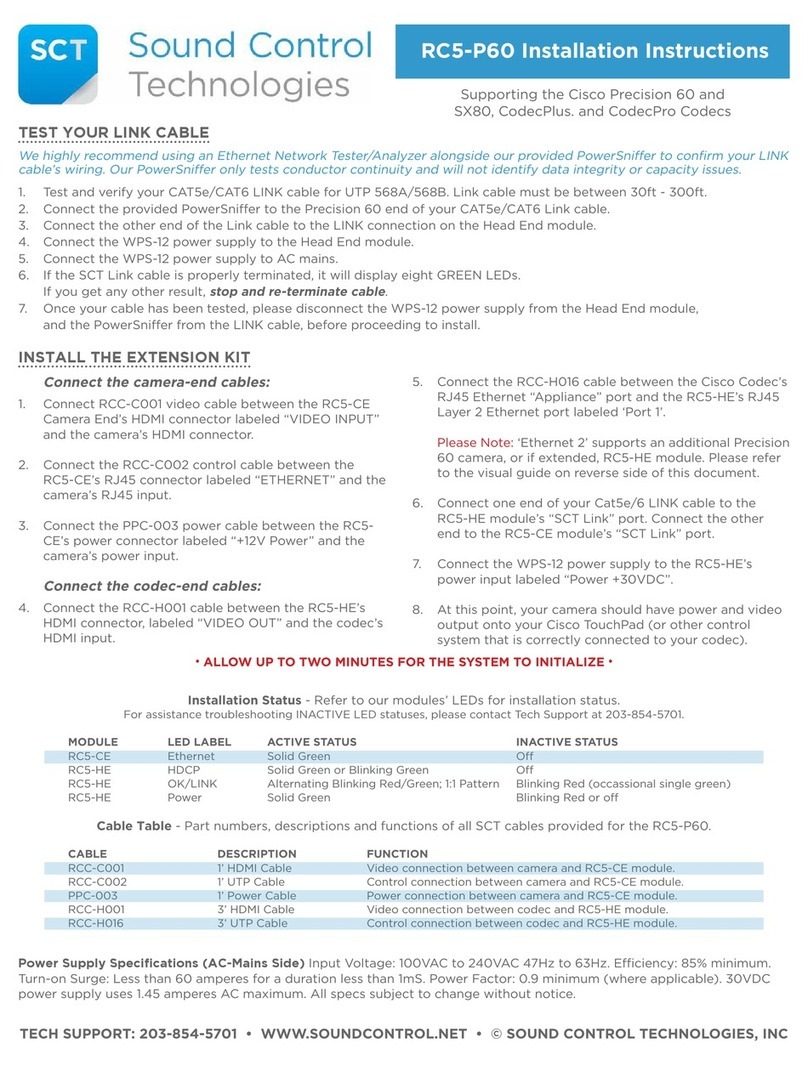
SCT
SCT RC5-P60 installation instructions

Bosch
Bosch MIC-67SUNSHLD Quick installation guide
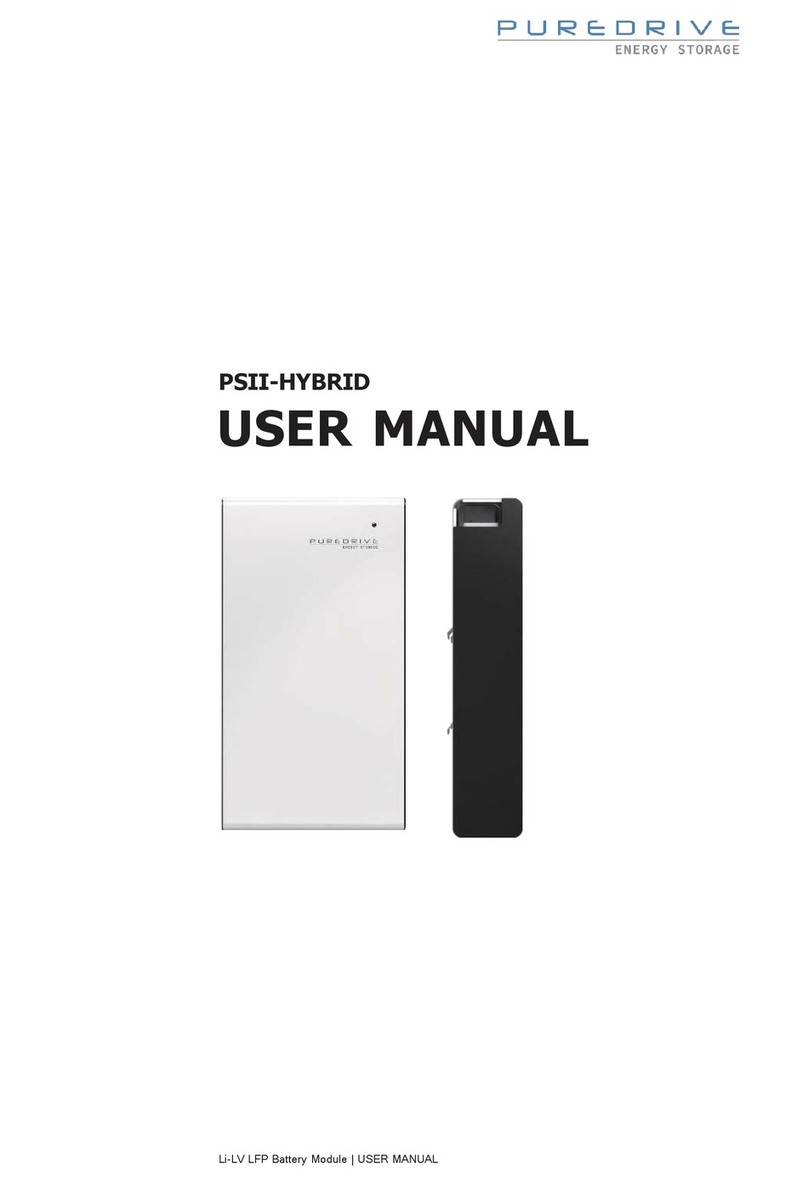
Puredrive
Puredrive PureStorage II user manual

Chesapeake & Midlantic
Chesapeake & Midlantic BMT-70A10 installation manual
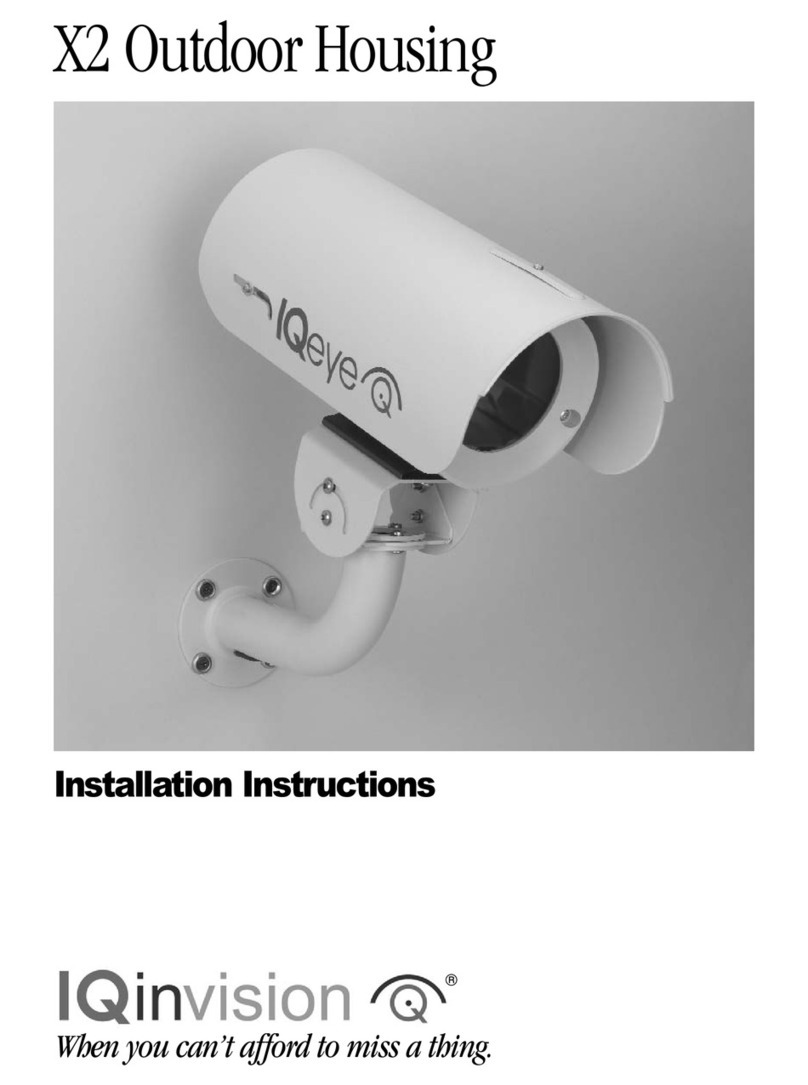
Iqinvision
Iqinvision X2 installation instructions

Vello
Vello FreeWave Fusion Basic user manual
